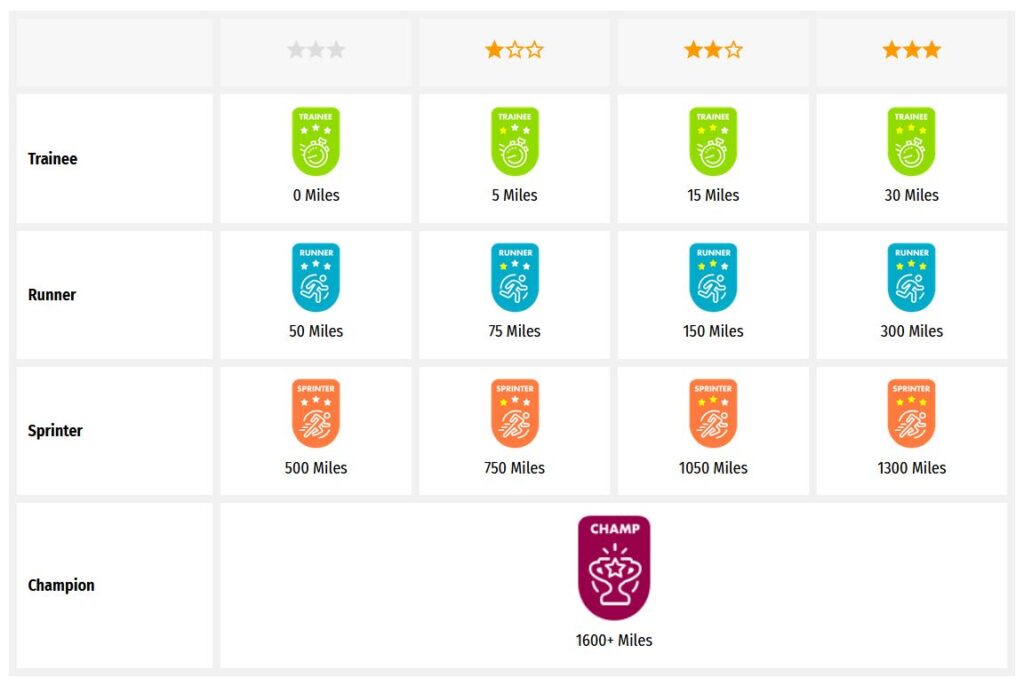Someone else is currently editing this document
Only one person can work on a document at a time
TRANSCRIPTION
Left page:
Top left: black and white photograph of a man reading a book in between library stacks with the caption:
The Liddle Collection closed access store
Top right: black and white photograph of various papers, photographs, and objects including a pair of boots, with the caption:
Archive materials of Dr W. S. Macdonald, MC
experience documentation of service in even the most remote regions
is included, with material relating to China (Tsing Tao), Aden, the
Cameroons, and all of the 'Minor Fronts'.
Two distinctive elements characterize the holdings of the Collection.
The first is that the physical integrity of all the disparate elements of
the surviving record of a man or a woman's experience is consistently
maintained: no departmentalization destroys the inter-relationship of an
individual's photographs, correspondence, tape-recorded recollections,
or three-dimensional souvenirs, which are either kept all together or
can be assembled very quickly.
The second distinctive element is that the content of each set of
papers has been thoroughly explored and the findings are readily
available by means of a topic cross-reference system. This enables the
enquirer to know precisely where there is evidence relating to a particular
battle or a given subject of research (for example, morale, or infantry
tactics at a certain stage of the war), and also where there are letters or
diary entries which indicate what individuals felt about the war and
their army service, their regimental officers, the Germans, Belgian
peasants, fundamental concerns such as food, comforts, or lice, and
about spiritual or philosophical matters. The close study of such evidence
is vital in any reappraisal of the many glib generalizations frequently
made about First World War experience.
The Collection has long been widely known for its British and
Commonwealth holdings on the Dardanelles Gallipoli campaign. The
same is true also, at the level of junior regimental officer and of men
in the ranks, of the Mesopotamian, Macedonian and Egypt/Palestine
campaigns. There is outstanding coverage of the pilots, observers and
ground personnel of the Air Arm and of the sub-lieutenants, midshipmen
Right page:
and ratings of the Royal Navy. Peter Liddle's published trilogy,
The Sailor's War (1985), The Airman's War (1987), and The Soldier's War
(1988), indicates the range and fascination of the material available for
study.
Black and white photograph of two men and a woman examining an object in a library, with the caption:
HRH the Duchess of Kent, Chancellor of the University,
visits the Liddle Collection, March 1989
In the General Section of the Collection are held the papers of men
who served on the Western Front or on more than one front. There are
further sections containing the holdings for Mesopotamia, Macedonia,
Egypt and Palestine, Italy, Aden, West Africa, the Sudan, East Africa,
Southern Africa, Persia, Russia, India, Burma, China and the Pacific.
The RFC, the RNAS and the RAF have their own holdings list and
topic cross-reference index, as does the Royal Navy and Merchant
Marine. There are separate sections also for Prisoners of War, British
civilian internees at Ruhleben, the Domestic Front, Women's overseas
service, Australians and New Zealanders, French and German service,
Friends Ambulance Unit work and Conscientious Objection. There are
catalogued map holdings for each front, a list of the extensive newspapers
and trench newssheets, a tape-recording card index system and
a card index system for those individuals whose material is solely that
of manuscript or typescript recollections. A regimental cross-reference
arrangement is the means by which unit-based research can be conducted;
there is a catalogue of the fascinating 'museum object' material,
and there are folders of typed transcriptions of some of the most
significant tape-recordings.
Language(s) of Transcription
LOCATION
Shrewsbury, England (52.7073, -2.75533)
Story Location
ABOUT THIS DOCUMENT
Document Date
Document Type
Document Description
Language of Description
Keywords
External Web Resources
People
Mary Maria Squire
wilfred ashworth
STORY INFORMATION
Title
Berrington Hospital | autograph book of Mary Maria Squire
Source
UGC
Contributor
europeana19141918:agent/fc19f48ff6a55345a0dddea6fe6baedf
Type
Story
Language
eng
English
Country
Europe
DataProvider
Europeana 1914-1918
Provider
Europeana 1914-1918
Rights
http://creativecommons.org/publicdomain/zero/1.0/ http://creativecommons.org/licenses/by-sa/3.0/Year
1916
1919
DatasetName
2020601_Ag_ErsterWeltkrieg_EU
Begin
1916
Sat Jan 01 00:19:32 CET 1916
Wed Jan 01 00:19:32 CET 1919
Tue Jan 01 00:19:32 CET 1901
End
1919
Sun Dec 31 00:19:32 CET 1916
Wed Dec 31 00:19:32 CET 1919
Sun Dec 31 01:00:00 CET 2000
Sun Dec 31 00:19:32 CET 1933
Language
mul
Agent
Mary Maria Squire | europeana19141918:agent/be0ba0b5c9899505dd7e3371585048a3
wilfred ashworth | europeana19141918:agent/d6f3f7f073eef0a27468e5503a5afed0
Anthony Draper-Smith | europeana19141918:agent/fc19f48ff6a55345a0dddea6fe6baedf
Created
2019-09-11T08:38:42.204Z
2019-09-11T08:38:42.177Z
2012-03-27 15:19:37 UTC
Provenance
PR17
Story Description
Berrington Hospital
TRANSCRIPTION
LOCATION
DESCRIPTION
PEOPLE
STORY INFO
TUTORIAL
Left page:
Top left: black and white photograph of a man reading a book in between library stacks with the caption:
The Liddle Collection closed access store
Top right: black and white photograph of various papers, photographs, and objects including a pair of boots, with the caption:
Archive materials of Dr W. S. Macdonald, MC
experience documentation of service in even the most remote regions
is included, with material relating to China (Tsing Tao), Aden, the
Cameroons, and all of the 'Minor Fronts'.
Two distinctive elements characterize the holdings of the Collection.
The first is that the physical integrity of all the disparate elements of
the surviving record of a man or a woman's experience is consistently
maintained: no departmentalization destroys the inter-relationship of an
individual's photographs, correspondence, tape-recorded recollections,
or three-dimensional souvenirs, which are either kept all together or
can be assembled very quickly.
The second distinctive element is that the content of each set of
papers has been thoroughly explored and the findings are readily
available by means of a topic cross-reference system. This enables the
enquirer to know precisely where there is evidence relating to a particular
battle or a given subject of research (for example, morale, or infantry
tactics at a certain stage of the war), and also where there are letters or
diary entries which indicate what individuals felt about the war and
their army service, their regimental officers, the Germans, Belgian
peasants, fundamental concerns such as food, comforts, or lice, and
about spiritual or philosophical matters. The close study of such evidence
is vital in any reappraisal of the many glib generalizations frequently
made about First World War experience.
The Collection has long been widely known for its British and
Commonwealth holdings on the Dardanelles Gallipoli campaign. The
same is true also, at the level of junior regimental officer and of men
in the ranks, of the Mesopotamian, Macedonian and Egypt/Palestine
campaigns. There is outstanding coverage of the pilots, observers and
ground personnel of the Air Arm and of the sub-lieutenants, midshipmen
Right page:
and ratings of the Royal Navy. Peter Liddle's published trilogy,
The Sailor's War (1985), The Airman's War (1987), and The Soldier's War
(1988), indicates the range and fascination of the material available for
study.
Black and white photograph of two men and a woman examining an object in a library, with the caption:
HRH the Duchess of Kent, Chancellor of the University,
visits the Liddle Collection, March 1989
In the General Section of the Collection are held the papers of men
who served on the Western Front or on more than one front. There are
further sections containing the holdings for Mesopotamia, Macedonia,
Egypt and Palestine, Italy, Aden, West Africa, the Sudan, East Africa,
Southern Africa, Persia, Russia, India, Burma, China and the Pacific.
The RFC, the RNAS and the RAF have their own holdings list and
topic cross-reference index, as does the Royal Navy and Merchant
Marine. There are separate sections also for Prisoners of War, British
civilian internees at Ruhleben, the Domestic Front, Women's overseas
service, Australians and New Zealanders, French and German service,
Friends Ambulance Unit work and Conscientious Objection. There are
catalogued map holdings for each front, a list of the extensive newspapers
and trench newssheets, a tape-recording card index system and
a card index system for those individuals whose material is solely that
of manuscript or typescript recollections. A regimental cross-reference
arrangement is the means by which unit-based research can be conducted;
there is a catalogue of the fascinating 'museum object' material,
and there are folders of typed transcriptions of some of the most
significant tape-recordings.
- English (English)
Left page:
Top left: black and white photograph of a man reading a book in between library stacks with the caption:
The Liddle Collection closed access store
Top right: black and white photograph of various papers, photographs, and objects including a pair of boots, with the caption:
Archive materials of Dr W. S. Macdonald, MC
experience documentation of service in even the most remote regions
is included, with material relating to China (Tsing Tao), Aden, the
Cameroons, and all of the 'Minor Fronts'.
Two distinctive elements characterize the holdings of the Collection.
The first is that the physical integrity of all the disparate elements of
the surviving record of a man or a woman's experience is consistently
maintained: no departmentalization destroys the inter-relationship of an
individual's photographs, correspondence, tape-recorded recollections,
or three-dimensional souvenirs, which are either kept all together or
can be assembled very quickly.
The second distinctive element is that the content of each set of
papers has been thoroughly explored and the findings are readily
available by means of a topic cross-reference system. This enables the
enquirer to know precisely where there is evidence relating to a particular
battle or a given subject of research (for example, morale, or infantry
tactics at a certain stage of the war), and also where there are letters or
diary entries which indicate what individuals felt about the war and
their army service, their regimental officers, the Germans, Belgian
peasants, fundamental concerns such as food, comforts, or lice, and
about spiritual or philosophical matters. The close study of such evidence
is vital in any reappraisal of the many glib generalizations frequently
made about First World War experience.
The Collection has long been widely known for its British and
Commonwealth holdings on the Dardanelles Gallipoli campaign. The
same is true also, at the level of junior regimental officer and of men
in the ranks, of the Mesopotamian, Macedonian and Egypt/Palestine
campaigns. There is outstanding coverage of the pilots, observers and
ground personnel of the Air Arm and of the sub-lieutenants, midshipmen
Right page:
and ratings of the Royal Navy. Peter Liddle's published trilogy,
The Sailor's War (1985), The Airman's War (1987), and The Soldier's War
(1988), indicates the range and fascination of the material available for
study.
Black and white photograph of two men and a woman examining an object in a library, with the caption:
HRH the Duchess of Kent, Chancellor of the University,
visits the Liddle Collection, March 1989
In the General Section of the Collection are held the papers of men
who served on the Western Front or on more than one front. There are
further sections containing the holdings for Mesopotamia, Macedonia,
Egypt and Palestine, Italy, Aden, West Africa, the Sudan, East Africa,
Southern Africa, Persia, Russia, India, Burma, China and the Pacific.
The RFC, the RNAS and the RAF have their own holdings list and
topic cross-reference index, as does the Royal Navy and Merchant
Marine. There are separate sections also for Prisoners of War, British
civilian internees at Ruhleben, the Domestic Front, Women's overseas
service, Australians and New Zealanders, French and German service,
Friends Ambulance Unit work and Conscientious Objection. There are
catalogued map holdings for each front, a list of the extensive newspapers
and trench newssheets, a tape-recording card index system and
a card index system for those individuals whose material is solely that
of manuscript or typescript recollections. A regimental cross-reference
arrangement is the means by which unit-based research can be conducted;
there is a catalogue of the fascinating 'museum object' material,
and there are folders of typed transcriptions of some of the most
significant tape-recordings.
Language(s) of Transcription
English Translation
Left page:
Top left: black and white photograph of a man reading a book in between library stacks with the caption:
The Liddle Collection closed access store
Top right: black and white photograph of various papers, photographs, and objects including a pair of boots, with the caption:
Archive materials of Dr W.
S.
Macdonald, MC
experience documentation of service in even the most remote regions
is included, with material relating to China (Tsing Tao), Aden, the
Cameroons, and all of the 'Minor Fronts'.
Two distinctive elements characterize the holdings of the Collection.
The first is that the physical integrity of all the disparate elements of
the surviving record of a man or a woman's experience is consistently
maintained: no departmentalization destroys the inter-relationship of an
individual's photographs, correspondence, tape-recorded recollections,
or three-dimensional souvenirs, which are either kept all together or
can be assembled very quickly.
The second distinctive element is that the content of each set of
papers has been thoroughly explored and the findings are readily
available by means of a topic cross-reference system.
This enables the
enquirer to know precisely where there is evidence relating to a particular
battle or a given subject of research (for example, morale, or infantry
tactics at a certain stage of the war), and also where there are letters or
diary entries which indicate what individuals felt about the war and
their army service, their regimental officers, the Germans, Belgian
peasants, fundamental concerns such as food, comforts, or lice, and
about spiritual or philosophical matters.
The close study of such evidence
is vital in any reappraisal of the many glib generalizations frequently
made about First World War experience.
The Collection has long been widely known for its British and
Commonwealth holdings on the Dardanelles Gallipoli campaign.
The
same is true also, at the level of junior regimental officer and of men
in the ranks, of the Mesopotamian, Macedonian and Egypt/Palestine
campaigns.
There is outstanding coverage of the pilots, observers and
ground personnel of the Air Arm and of the sub-lieutenants, midshipmen
Right page:
and ratings of the Royal Navy.
Peter Liddle's published trilogy,
The Sailor's War (1985), The Airman's War (1987), and The Soldier's War
(1988), indicates the range and fascination of the material available for
study.
Black and white photograph of two men and a woman examining an object in a library, with the caption:
HRH the Duchess of Kent, Chancellor of the University,
visits the Liddle Collection, March 1989
In the General Section of the Collection are held the papers of men
who served on the Western Front or on more than one front.
There are
further sections containing the holdings for Mesopotamia, Macedonia,
Egypt and Palestine, Italy, Aden, West Africa, the Sudan, East Africa,
Southern Africa, Persia, Russia, India, Burma, China and the Pacific.
The RFC, the RNAS and the RAF have their own holdings list and
topic cross-reference index, as does the Royal Navy and Merchant
Marine.
There are separate sections also for Prisoners of War, British
civilian internees at Ruhleben, the Domestic Front, Women's overseas
service, Australians and New Zealanders, French and German service,
Friends Ambulance Unit work and Conscientious Objection.
There are
catalogued map holdings for each front, a list of the extensive newspapers
and trench newssheets, a tape-recording card index system and
a card index system for those individuals whose material is solely that
of manuscript or typescript recollections.
A regimental cross-reference
arrangement is the means by which unit-based research can be conducted;
there is a catalogue of the fascinating 'museum object' material,
and there are folders of typed transcriptions of some of the most
significant tape-recordings.
Transcription History
Left page: Top left: black and white photograph of a man reading a book in between library stacks with the caption: The Liddle Collection closed access store Top right: black and white photograph of various papers, photographs, and objects including a pair of boots, with the caption: Archive materials of Dr W. S. Macdonald, MC experience documentation of service in even the most remote regions is included, with material relating to China (Tsing Tao), Aden, the Cameroons, and all of the 'Minor Fronts'. Two distinctive elements characterize the holdings of the Collection. The first is that the physical integrity of all the disparate elements of the surviving record of a man or a woman's experience is consistently maintained: no departmentalization destroys the inter-relationship of an individual's photographs, correspondence, tape-recorded recollections, or three-dimensional souvenirs, which are either kept all together or can be assembled very quickly. The second distinctive element is that the content of each set of papers has been thoroughly explored and the findings are readily available by means of a topic cross-reference system. This enables the enquirer to know precisely where there is evidence relating to a particular battle or a given subject of research (for example, morale, or infantry tactics at a certain stage of the war), and also where there are letters or diary entries which indicate what individuals felt about the war and their army service, their regimental officers, the Germans, Belgian peasants, fundamental concerns such as food, comforts, or lice, and about spiritual or philosophical matters. The close study of such evidence is vital in any reappraisal of the many glib generalizations frequently made about First World War experience. The Collection has long been widely known for its British and Commonwealth holdings on the Dardanelles Gallipoli campaign. The same is true also, at the level of junior regimental officer and of men in the ranks, of the Mesopotamian, Macedonian and Egypt/Palestine campaigns. There is outstanding coverage of the pilots, observers and ground personnel of the Air Arm and of the sub-lieutenants, midshipmen Right page: and ratings of the Royal Navy. Peter Liddle's published trilogy, The Sailor's War (1985), The Airman's War (1987), and The Soldier's War (1988), indicates the range and fascination of the material available for study. Black and white photograph of two men and a woman examining an object in a library, with the caption: HRH the Duchess of Kent, Chancellor of the University, visits the Liddle Collection, March 1989 In the General Section of the Collection are held the papers of men who served on the Western Front or on more than one front. There are further sections containing the holdings for Mesopotamia, Macedonia, Egypt and Palestine, Italy, Aden, West Africa, the Sudan, East Africa, Southern Africa, Persia, Russia, India, Burma, China and the Pacific. The RFC, the RNAS and the RAF have their own holdings list and topic cross-reference index, as does the Royal Navy and Merchant Marine. There are separate sections also for Prisoners of War, British civilian internees at Ruhleben, the Domestic Front, Women's overseas service, Australians and New Zealanders, French and German service, Friends Ambulance Unit work and Conscientious Objection. There are catalogued map holdings for each front, a list of the extensive newspapers and trench newssheets, a tape-recording card index system and a card index system for those individuals whose material is solely that of manuscript or typescript recollections. A regimental cross-reference arrangement is the means by which unit-based research can be conducted; there is a catalogue of the fascinating 'museum object' material, and there are folders of typed transcriptions of some of the most significant tape-recordings.
Left page: Top left: black and white photograph of a man reading a book in between library stacks with the caption: The Liddle Collection closed access store Top right: black and white photograph of various papers, photographs, and objects including a pair of boots, with the caption: Archive materials of Dr W. S. Macdonald, MC experience documentation of service in even the most remote regions is included, with material relating to China (Tsing Tao), Aden, the Cameroons, and all of the 'Minor Fronts'. Two distinctive elements characterize the holdings of the Collection. The first is that the physical integrity of all the disparate elements of the surviving record of a man or a woman's experience is consistently maintained: no departmentalization destroys the inter-relationship of an individual's photographs, correspondence, tape-recorded recollections, or three-dimensional souvenirs, which are either kept all together or can be assembled very quickly. The second distinctive element is that the content of each set of papers has been thoroughly explored and the findings are readily available by means of a topic cross-reference system. This enables the enquirer to know precisely where there is evidence relating to a particular battle or a given subject of research (for example, morale, or infantry tactics at a certain stage of the war), and also where there are letters or diary entries which indicate what individuals felt about the war and their army service, their regimental officers, the Germans, Belgian peasants, fundamental concerns such as food, comforts, or lice, and about spiritual or philosophical matters. The close study of such evidence is vital in any reappraisal of the many glib generalizations frequently made about First World War experience. The Collection has long been widely known for its British and Commonwealth holdings on the Dardanelles Gallipoli campaign. The same is true also, at the level of junior regimental officer and of men in the ranks, of the Mesopotamian, Macedonian and Egypt/Palestine campaigns. There is outstanding coverage of the pilots, observers and ground personnel of the Air Arm and of the sub-lieutenants, midship-
English Translation
Automatically Identified Enrichments
Verify Automatically Identified Enrichments
Verify Automatically Identified Locations
Verify Automatically Identified Persons
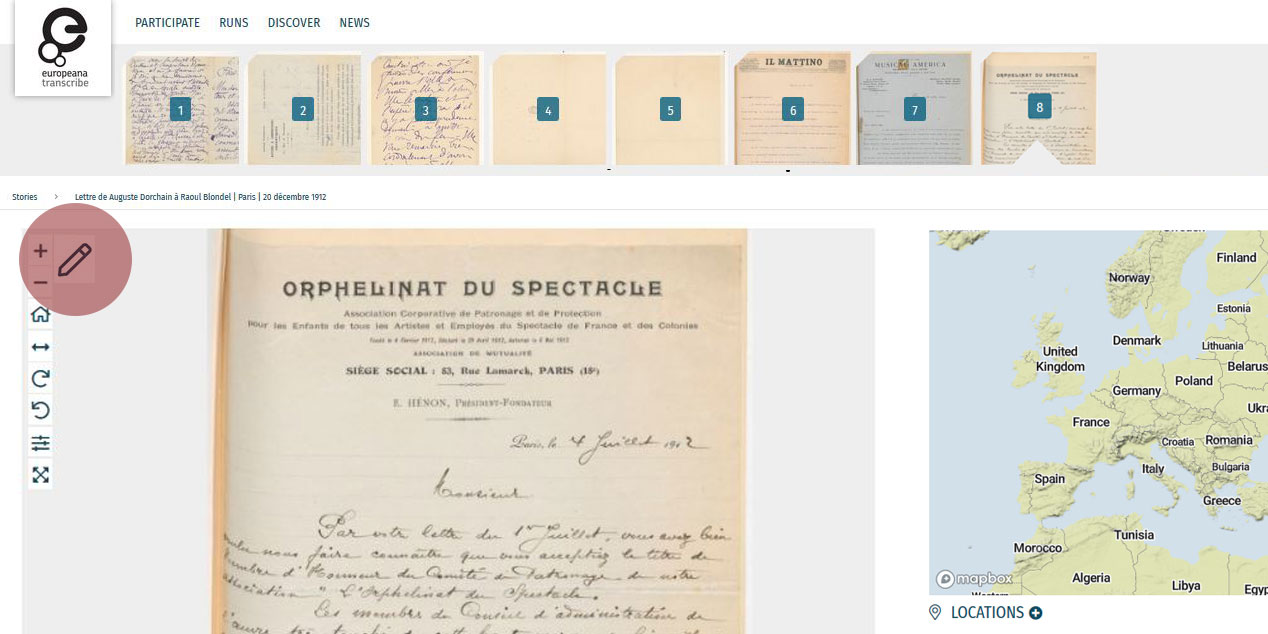
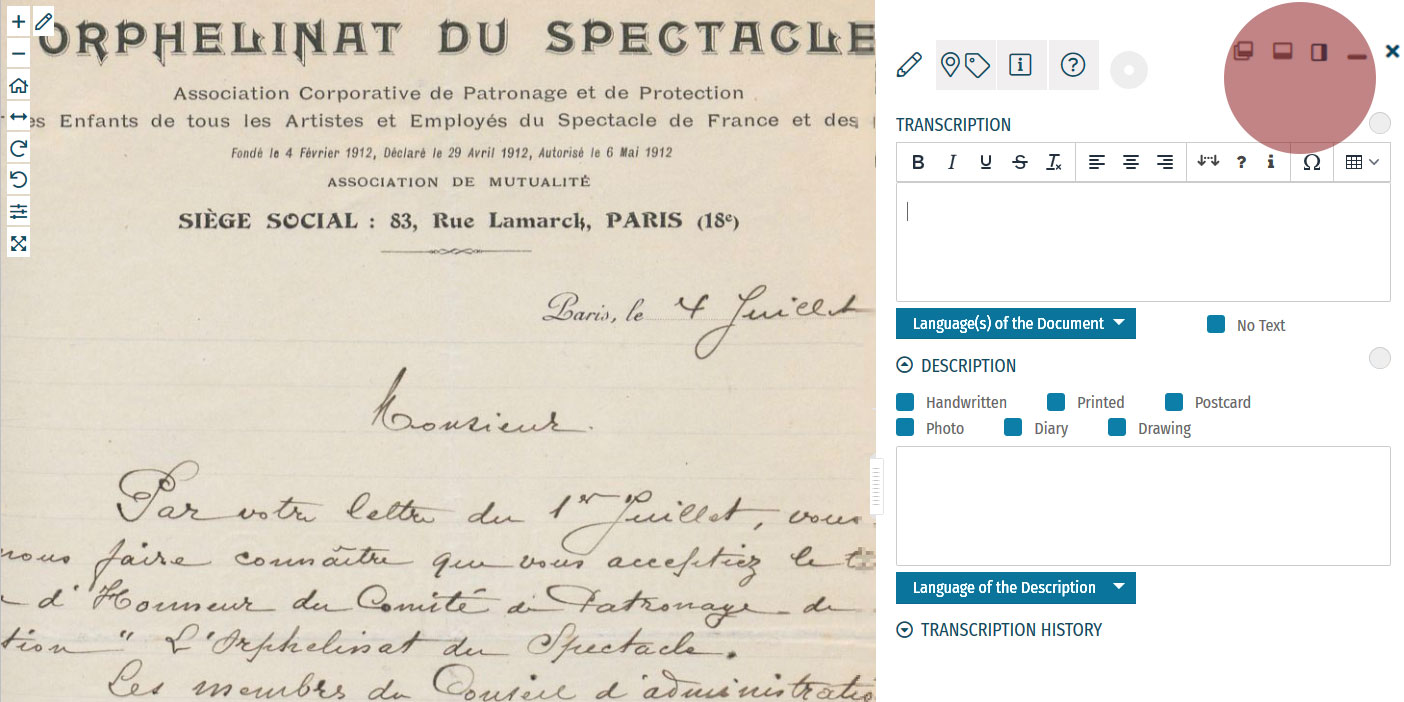
Enrichment Mode
Edit your workspace view by using the top-right menu.
You can have the white Activity Panel docked to the right (default) , to the bottom , or as an independent overlay . If you just want to view the image, you can hide the panel using the minimise button , and then re-open it with the pen button. Adjust the size and position of your Activity Panel according to your preferences.
You enrich documents by following a step-by-step process.
Make sure you regularly save your enrichments in each step to avoid the risk of losing your work.
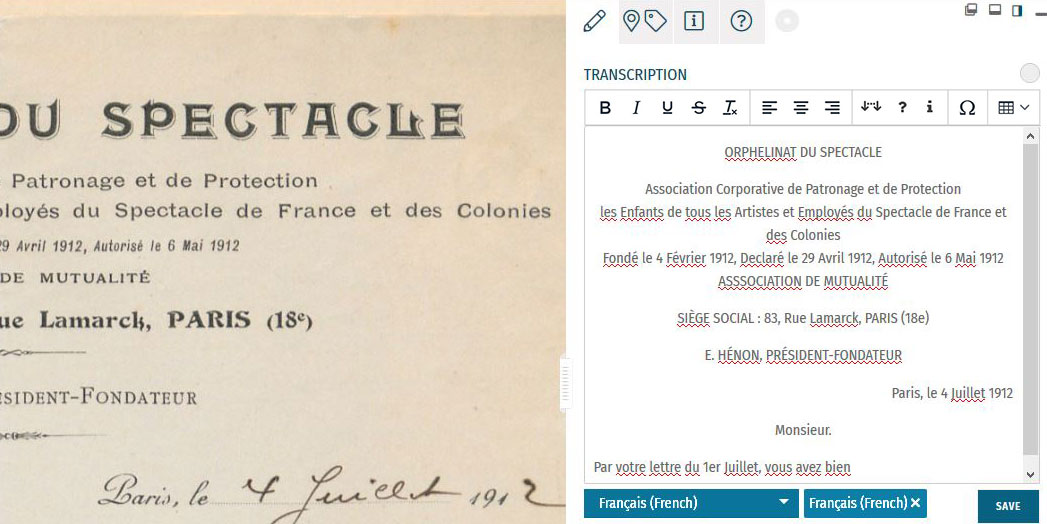
Step 1: Transcription
To start a transcription, select the transcription tab at the top menu of the Activity Panel. Click inside the box underneath the heading TRANSCRIPTION and start writing your transcription. When needed, use the toolbar to format your text and to add special characters and tables. A guide to the transcription toolbar is available in the Formatting section of this tutorial.
Identify the language(s) of the text using the dropdown list under the transcription box. You can select multiple languages at once.
If the item has no text to transcribe, tick the checkbox ‘No Text’.
Once you have finished your transcription, click SAVE.
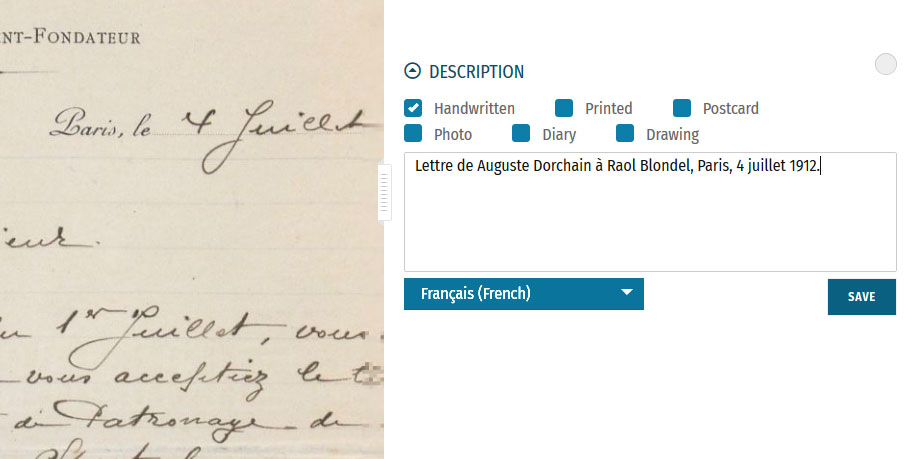
Step 2: Description
You can add a description to the item underneath the Transcription section.
The first task is to identify what type of document the item is: a handwritten or printed document, a postcard, photo, drawing and/or part of a diary. Tick the category which best applies to the item. Multiple categories can be selected at once.
The second task is to write a description of the contents. Click inside the box underneath the heading DESCRIPTION. Here, you can write what the item is, what it is about, and specify the images and objects that appear in the item.
Identify the language of the description text that you wrote using the dropdown list underneath. You can only select one language.
Once you have finished your description, click SAVE.
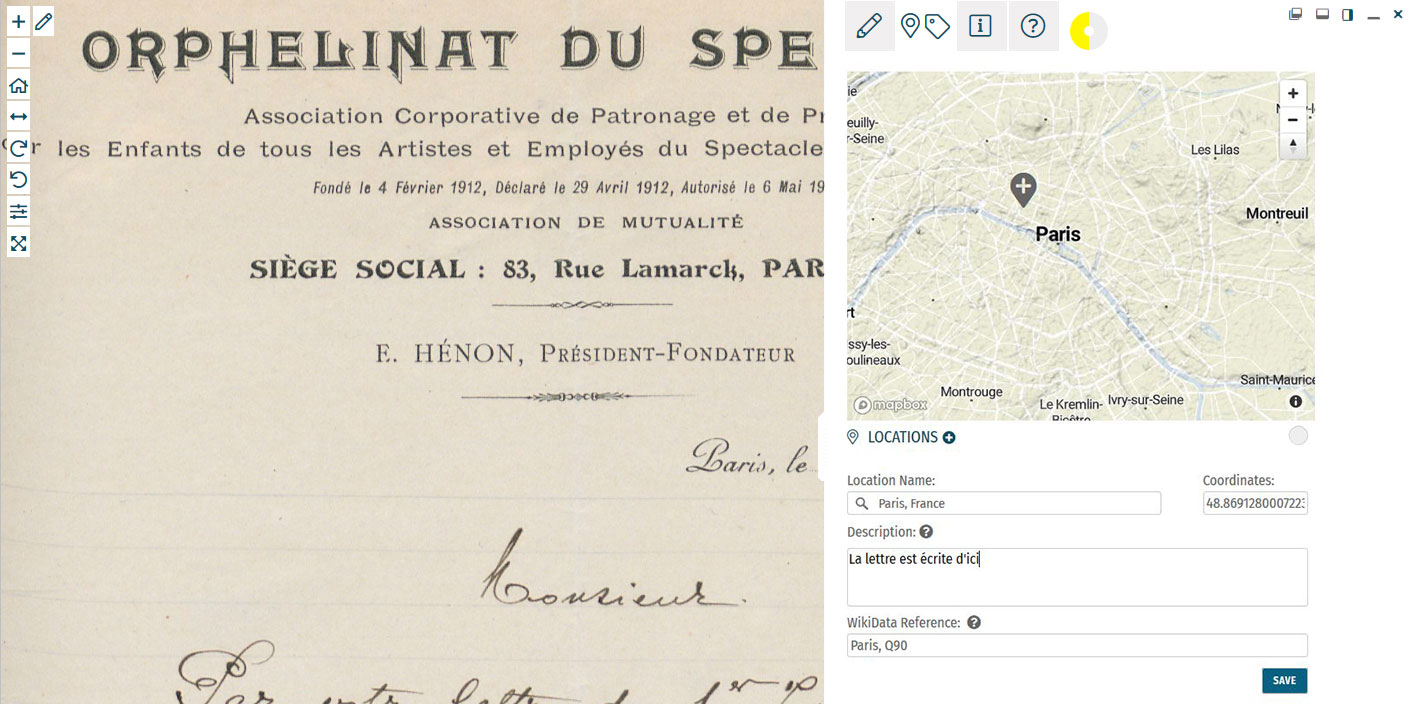
Step 3: Location
If you find a location mentioned or recognise a place in the item, you can create a geotag and pin it to the item map. Multiple locations can be attached to the item. To tag locations, select the tagging tab at the top menu of the Activity Panel. Click the plus next to the heading LOCATIONS. Type the location into the search bar and select the result that best applies. A new pin will be placed into the map. The location name should be a clear georeference, e.g. a country, city or address. Make adjustments to the location name if necessary. You can also adjust the position of the pin by dragging it on the map. If you want to add further details to the location, you can write a (short) description. This could include extra information about the geotag (e.g. the building name or a significant event that took place at the location) or the relevance of the place to the item (e.g. the hometown of the author). You can also add a Wikidata reference to link the location to a stable source. Search for the reference using the Wikidata fields. Once you have finished your location tag, click SAVE. You can find the place(s) tagged to the item in grey at the bottom of the Location(s) section.Step 4: Tagging
Below the Locations section is the Tagging section, where you can add the following annotations:
 Document Date:
Document Date:Here, you can add dates that correspond to the item. This could include the dates mentioned in the text (e.g. in diary pages), the date of a related historical event (e.g. the end of WWI), or when the item was created (e.g. from a dated signature on an illustration). You can either define this as a single date or as a longer time frame.
To tag dates to the item, write the start and end dates in DD/MM/YYYY format in the fields or select the dates by clicking on the calendar.
If you only have one date to add, insert the same date into both start and end fields.
If you don’t know the exact days, you can also tag the date on the scale of months (MM/YYYY) or years (YYYY).
Once you have finished your date tag, click SAVE DATE.
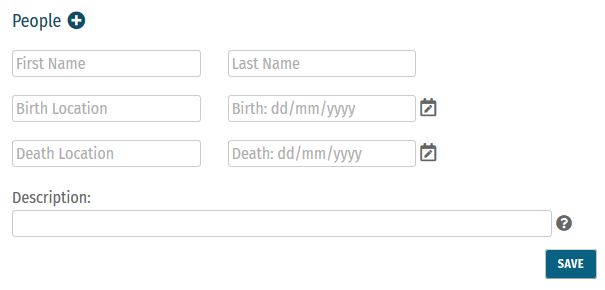 People:
People:People mentioned as creators or subjects in the item can also be tagged. Depending on the information you might have, you can enter the person’s first and last names, as well as their dates of birth and death. There is also the option to write a short description of the person, explaining who they are or their relevance to the item, e.g. the person’s occupation or their relation to another tagged person.
Multiple people can be tagged to one item.
Once you have finished your person tag, click SAVE.
 Keywords:
Keywords:Here, you can freely add keywords related to the topic and content of the item. This could include particular themes (e.g. art, music, war), subjects (e.g. children, cooking, France), or particular historical affiliations (e.g. 20th century, Austro-Hungarian Empire, Fall of the Iron Curtain).
Multiple keywords can be added and they can be written in any language.
Write your keyword tag into the field and click SAVE.
 Other Sources:
Other Sources:External websites with information about the item’s content can be linked here. This could include links to further data about a person mentioned, a particular historical event or links to digital versions of newspapers that appear in photos or clippings in a notebook.
To add a link, click the plus next to the heading ‘Other Sources’. Enter the URL into the Link field, and write a short description of this link in the Additional Description field.
Multiple links can be tagged to one item.
Once you have finished your tag, click SAVE.
Step 5: Mark for Review
Once you have saved your contribution, the task will automatically change to the Edit status. If you think the task is finished, you can mark it for review. Note that you have to be at Runner level or above to do this (see: Miles and Levels). Click on the yellow circle next to the section heading and select Review in the list that appears. The task now needs to go under Review by another volunteer.Formatting
Review
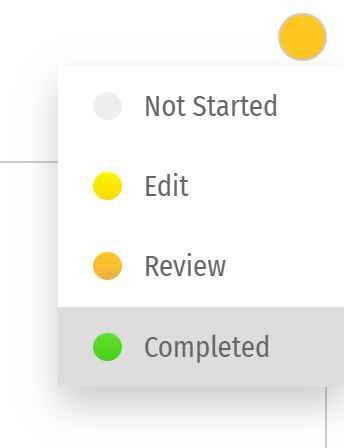 All enrichments need to be edited and reviewed by more than one volunteer to ensure that they are as accurate as possible.
Only Sprinters and Champions can edit tasks in the Review stage and mark them as Complete. (see: Miles and Levels)
You can review a task (Transcription, Description, Locations, or Tagging) when the circle next to the heading is coloured orange .
During the review process, pay close attention to the following requirements:
All enrichments need to be edited and reviewed by more than one volunteer to ensure that they are as accurate as possible.
Only Sprinters and Champions can edit tasks in the Review stage and mark them as Complete. (see: Miles and Levels)
You can review a task (Transcription, Description, Locations, or Tagging) when the circle next to the heading is coloured orange .
During the review process, pay close attention to the following requirements:
-
- Transcription: The complete text in the item has been properly transcribed and the transcription is formatted as accurately as possible. The correct language(s) are selected and the transcription contains no missing or unclear icons.
-
- Description: The description is accurate and detailed (especially items without text to transcribe, e.g. photos), and the appropriate categories have been ticked.
-
- Location(s): All locations have been correctly tagged. The location name is accurate and matches the coordinates and the pin on the map. The description is clear and concise, and the Wikidata reference (if any) is correct.
-
- Tagging: Document dates are completed and as precise as possible. All mentioned people are tagged and their data is correct. All added keywords are applicable to the item, and other sources have accurate information and functioning links.
Completion Statuses
| GREY |
| 1. NOT STARTED |
| Tasks have not been started. |
| YELLOW |
| 2. EDIT MODE |
| Tasks have been started, but not yet finished. Additions and edits can still be made. |
| ORANGE |
| 3. REVIEW |
| Tasks are finished, but need final review by Sprinter or Champion transcribers. |
| GREEN |
| 4. COMPLETED |
| Tasks have been fully completed and reviewed. No further changes need to be made. |
Miles and Levels
Transcribathon is a competitive marathon. You do not enrich documents alone, but compete and work with other volunteers to ensure the quality of your work. When you first create a Transcribathon account, you only have the ability to start and edit tasks. The more you enrich documents, the closer you become to advancing to a higher level, which can unlock abilities like reviewing and completing tasks.| Level | Abilities |
|---|---|
| Trainee | Basic abilities: start and edit tasks |
| Runner | Basic abilities, mark finished tasks for review |
| Sprinter | All Runner abilities, mark reviewed annotations as completed |
| Champion | All Sprinter abilities, mark reviewed transcriptions as completed |
| Tasks | Miles Received |
|---|---|
| Transcription | 1 Mile for every 300 characters transcribed |
| Description | 1 Mile for every 5 Descriptions added |
| Location | 1 Mile for every 5 Locations added |
| Tagging | 1 Mile for every 5 Tags added |
| Reviewing | 1 Mile for every 10 items marked as complete |
